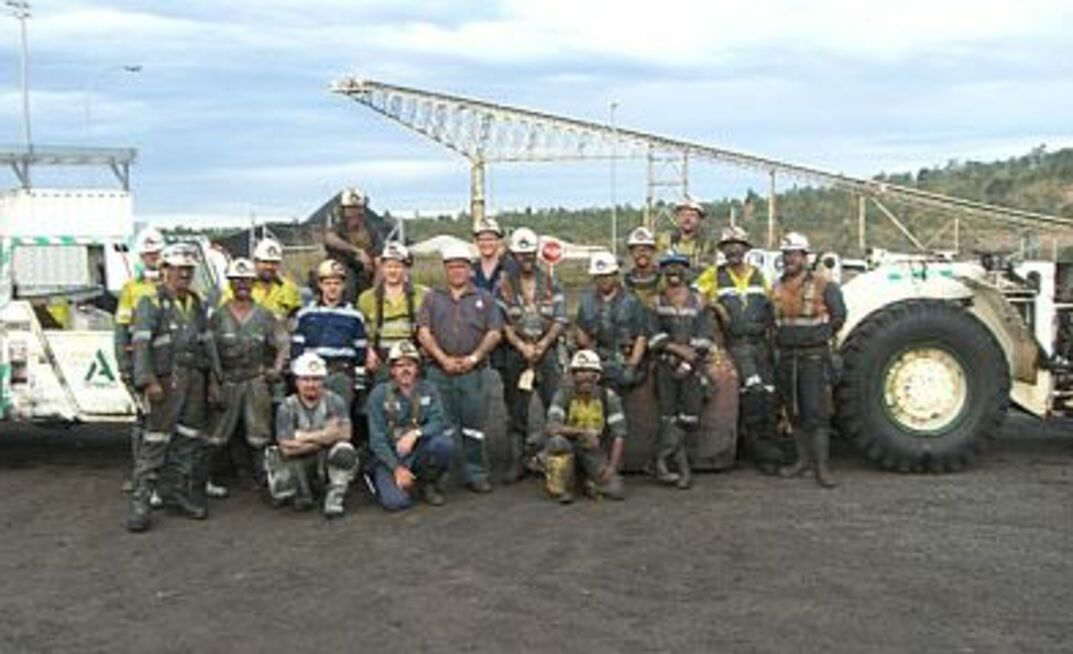Anderson Group holds the secondary support contract at the Capcoal operation, which includes the Central, Southern, Grasstree, Bundoora and Aquila underground mines.
Work at the mine consists of secondary roof support such as the installation of long tendon and standing supports, including cable bolts, mega bolts, bowen bolts, cogs, cans, link and loks; rib bolting and rib meshing; water management; conveyor installation and maintenance; roadworks; pipe range extensions/retractions; concreting; and ventilation work including the installation of seals, stoppings, overcasts, machine doors and regulators.
Accompanying this work are the typical mining conditions that can cause slips, trips, crushing and falls; machinery dangers; and environmental danger including roof/rib falls, heat, cold and gas.
“The major factor influencing a contractor’s ability to remain LTI free is the training and skill level of its employees and their willingness to embrace your safety culture as their own,” Anderson Group director Greg Anderson said.
“In this time of boom in the mining industry it is nigh on impossible to keep your employees for a long period of time due to the inflated wages and conditions being offered in the marketplace.
“It is commonplace to employ a ‘cleanskin’ employee and spend many hours and dollars training them to a high standard with a good safety culture, to then lose them. We have countered this by offering not only good wages and conditions, but a career path as well.”
Anderson said a big part of its safety success at Capcoal has been a low turnover of personnel and employees, allowing them to be advanced through training and mentoring to senior management positions.
“An example of this is Andy Mellish, who is senior project manager at Capcoal. He started onsite as a miner and within two years has progressed through shift boss, training officer, project manager to his current position of being accountable for the management of the complete Capcoal project,” he said.
Capcoal safety coordinator Shayne Daniels said compromising safety is not acceptable despite the challenge mines face during the current skills shortage.
“The biggest issue with contractors? It is the quality of supervisory staff. With the high turnover of personnel across the industry, supervisors are sometimes personnel with limited underground experience let alone leadership skills. Andersons have across our business shown that they have recruited wisely,” Daniels said.
Daniels also attributed improved safety to the use of partnership contracting. At the time of contract signing it was ensured Anderson’s system documentation complied with the mine’s system.
“The major issue in the past has been the hands-off distancing of the contractor and the principles management. The integration of the leadership and systems across the contract (partnership to a degree) has increased the performance of the contract company’s safety performance; we now help, through the term of the contract, to get good performance against past practice of utilising negative consequences,” he said.
“Integration begins at the awarding of contracts (systems review) then is implemented throughout the contract by all employees, including contractors attending our inductions and being trained to our standards. The signing off of Anderson's supervisors and trainer/assessors by our managers ensures that our systems and processes are supported by Andersons across the board.
“Andersons work across the business on what could best be described as projects. On these projects Anderson's leadership is responsible and held accountable for safety whilst engaged onsite. Capcoal supervisory staff are still accountable for statutory safety requirements underground.
“The good quality reporting and visible leadership means Capcoal can rely on Anderson’s supervisors for day-to-day safety. From the outcome we can see that this process has been successful.”
Daniels attributed Anderson’s success at Capcoal’s mines to leadership both at site and corporate level.
“Leaders drive safety by their actions and attitudes, both through visible leadership/communicating to all employees through good and bad times and supporting systems and practices through enforcement if and when required,” Daniels said.
According to Greg Anderson, since its inception, the Anderson Group has achieved a safety performance better than industry average, in line with its goals of a disabling injury frequency rate of zero for the calendar year. The safety management initiatives currently in place include:
Developing and implementing a comprehensive Fit for Duty policy;
Implementing an Accident Investigation System and allocating clear responsibilities for investigations;
Setting up of a thorough safety/compliance audit regime requiring all levels of management to conduct audits regularly;
Introducing pocket-size hazard report forms to increase hazard identification and reporting, whilst at the same time encouraging workers to rectify hazards whenever possible;
Introducing a No Blame Policy, which encourages employees to report all incidents by providing protection from disciplinary action if incidents are reported within a set timeframe. Also, making non-reporting of incidents/hazard an unacceptable behaviour and a serious offence resulting in disciplinary actions;
Establishing site-specific safety committees on sites with more than 30 employees. Electing site safety representative on sites with less than 30 employees;
Engaging in extensive consultation with workers resulting in the development of binding safety values that every employee must agree and adhere to;
Redefining safety responsibilities for all employees and incorporating safety key performance indicators in their personal performance appraisals; and
Implementing training programs, which provide staff and workers with risk identification and management and general safety training.
Anderson said currently a continuous improvement program is being developed, which will identify improvement opportunities in the areas of safety, cost reduction and production improvements.
Other initiatives currently being implemented include:
An external safety system audit, to identify opportunities for improvements;
Review of hazard/incident reporting/recording system and a critical evaluation of the effectiveness of the closeout loop within the system;
Extensive review of personal safety equipment; and
Development of a new procedure for purchasing new equipment. Ensuring safety aspects are a major consideration for purchase.
“Apart from...click here to read on.
























